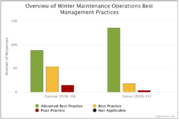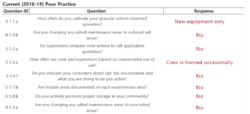
Difference between revisions of "Guidance for meeting chloride TMDL MS4 permit requirements"
| Line 10: | Line 10: | ||
There are currently 40 lakes and streams in the Twin Cities Metro Area that are <span title="Impaired waters are bodies of water that exceed the limits of one or more parameters for surface water quality"> [https://stormwater.pca.state.mn.us/index.php?title=Special_Waters_and_Impaired_Waters '''impaired''']</span> by chloride. There are an additional 10 lakes and streams that are impaired by chloride in greater Minnesota. See the [https://www.pca.state.mn.us/water/chloride-salts MPCA’s chloride webpage] for more information on the sources of chloride, environmental impacts, and opportunities for your community to reduce salt. | There are currently 40 lakes and streams in the Twin Cities Metro Area that are <span title="Impaired waters are bodies of water that exceed the limits of one or more parameters for surface water quality"> [https://stormwater.pca.state.mn.us/index.php?title=Special_Waters_and_Impaired_Waters '''impaired''']</span> by chloride. There are an additional 10 lakes and streams that are impaired by chloride in greater Minnesota. See the [https://www.pca.state.mn.us/water/chloride-salts MPCA’s chloride webpage] for more information on the sources of chloride, environmental impacts, and opportunities for your community to reduce salt. | ||
| − | The EPA has approved 40 <span title="the amount of a pollutant from both point and nonpoint sources that a waterbody can receive and still meet water quality standards"> [https://stormwater.pca.state.mn.us/index.php?title=Total_Maximum_Daily_Loads_(TMDLs) '''total maximum daily loads''']</span> (TMDLs) that include <span title="A municipal separate storm sewer system (MS4) is a means of transportation, individually or in a system, (e.g. roads with drainage systems, municipal streets, catch basins, curbs, gutters, ditches, man-made channels, storm drains, etc.) that are: owned or operated by a public entity (e.g. cities, townships, counties, military bases, hospitals, prison complexes, highway departments, universities, etc.) with jurisdiction over disposal of sewage, industrial wastes, stormwater, or other wastes. This includes special districts under State law (sewer, flood control, or drainage districts, etc.), an authorized Indian tribal organization, or a designated and approved management agency under section 208 of the Clean Water Act; designed or used for collecting or transporting stormwater; not a combined sewer; and not part of a publicly owned treatment works."> '''MS4'''</span> (Municipal Separate Storm Sewer System) <span title="the portion of a receiving water's assimilative capacity that is allocated to one of its existing or future point sources of pollution"> '''wasteload | + | The EPA has approved 40 <span title="the amount of a pollutant from both point and nonpoint sources that a waterbody can receive and still meet water quality standards"> [https://stormwater.pca.state.mn.us/index.php?title=Total_Maximum_Daily_Loads_(TMDLs) '''total maximum daily loads''']</span> (TMDLs) that include <span title="A municipal separate storm sewer system (MS4) is a means of transportation, individually or in a system, (e.g. roads with drainage systems, municipal streets, catch basins, curbs, gutters, ditches, man-made channels, storm drains, etc.) that are: owned or operated by a public entity (e.g. cities, townships, counties, military bases, hospitals, prison complexes, highway departments, universities, etc.) with jurisdiction over disposal of sewage, industrial wastes, stormwater, or other wastes. This includes special districts under State law (sewer, flood control, or drainage districts, etc.), an authorized Indian tribal organization, or a designated and approved management agency under section 208 of the Clean Water Act; designed or used for collecting or transporting stormwater; not a combined sewer; and not part of a publicly owned treatment works."> '''MS4'''</span> (Municipal Separate Storm Sewer System) <span title="the portion of a receiving water's assimilative capacity that is allocated to one of its existing or future point sources of pollution"> '''wasteload allocations'''</span> (WLAs) for chloride. Click [https://www.pca.state.mn.us/water/minnesotas-impaired-waters-list here] to link to MPCA's impaired waters website. A map illustrating U.S. EPA-approved listings for chloride is shown on the right. The TMDLs were developed as part of the [https://www.pca.state.mn.us/sites/default/files/wq-iw11-06e.pdf Twin Cities Area Metro Chloride TMDL], [https://www.pca.state.mn.us/water/tmdl/nine-mile-creek-turbidity-impaired-biota-and-chloride-tmdl-project Ninemile Creek TMDL], and the [https://www.pca.state.mn.us/water/tmdl/shingle-creek-chloride-tmdl-project Shingle Creek TMDL]. See the [https://www.pca.state.mn.us/water/statewide-chloride-resources statewide chloride resources page] for more information. |
==Permit requirements== | ==Permit requirements== | ||
Revision as of 20:36, 10 May 2020
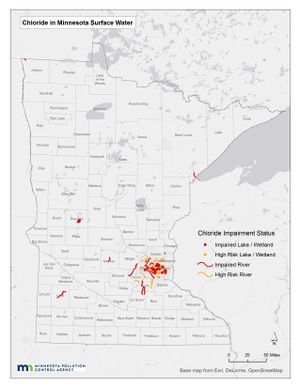
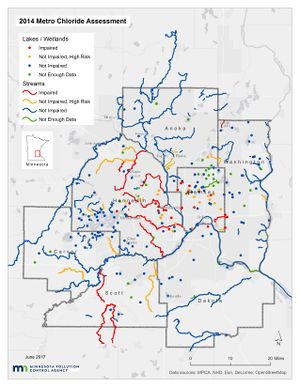
This page provides guidance for MS4 (Municipal Separate Storm Sewer System) permittees who have permit requirements for chloride total maximum daily load wasteload allocations.
Contents
Chloride Total Maximum Daily Loads (TMDLs)
There are currently 40 lakes and streams in the Twin Cities Metro Area that are impaired by chloride. There are an additional 10 lakes and streams that are impaired by chloride in greater Minnesota. See the MPCA’s chloride webpage for more information on the sources of chloride, environmental impacts, and opportunities for your community to reduce salt.
The EPA has approved 40 total maximum daily loads (TMDLs) that include MS4 (Municipal Separate Storm Sewer System) wasteload allocations (WLAs) for chloride. Click here to link to MPCA's impaired waters website. A map illustrating U.S. EPA-approved listings for chloride is shown on the right. The TMDLs were developed as part of the Twin Cities Area Metro Chloride TMDL, Ninemile Creek TMDL, and the Shingle Creek TMDL. See the statewide chloride resources page for more information.
Permit requirements
The MS4 permit contains the following requirements for permittees that have an applicable wasteload allocation (WLA) for chloride.
- Permit item 22.5: If the permittee has an applicable WLA for chloride, the permittee must document the amount of deicer applied each winter maintenance season to all permittee owned/operated surfaces
- Permit item 22.6: If the permittee has an applicable WLA for chloride, each calendar year the permittee must conduct an assessment of the permittee's winter maintenance operations to reduce the amount of deicing salt applied to permittee owned/operated surfaces and determine current and future opportunities to improve best management practices (BMPs). The permittee may use the Agency’s Smart Salting Assessment Tool or other available resources and methods to complete this assessment.
- The permittee must document the assessment. The assessment may include, but is not limited to:
- a. operational changes such as pre-wetting, pre-treating the salt stockpile, increasing plowing prior to deicing, monitoring of road surface temperature, etc.;
- b. implementation of new or modified equipment providing pre-wetting, or other capability for minimizing salt use;
- c. regular calibration of equipment;
- d. optimizing mechanical removal to reduce use of deicers; or
- e. designation of no salt and/or low salt zones.
- The permittee must document the assessment. The assessment may include, but is not limited to:
Guidance for meeting chloride TMDL permit requirements
Although the permit allows flexibility for permittees in documenting actions for meeting chloride TMDL requirements, several tools have been created to assist permittees in meeting requirements. These recommended resources are described below.
Document the amount of deicer applied
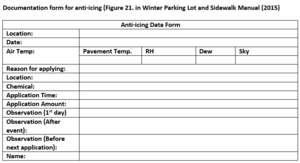
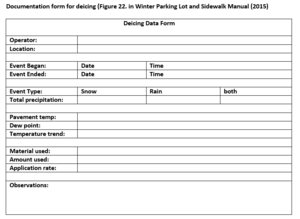
Permit item 22.5 - If the permittee has an applicable WLA for chloride, the permittee must document the amount of deicer applied each winter maintenance season to all permittee owned/operated surfaces
Permittees are required to track the amount of deicer applied. For each application event, permittees should also consider tracking the following.
- material used (e.g. sodium chloride, calcium chloride, etc.)
- location where material was applied
- date
- air temperature
- pavement temperature
- relative humidity (RH)
- dew point
- cloud cover
- operator
- event start
- event end
- event type (e.g. snow, rain, both)
- total precipitation, and
- application rate.
The Minnesota Snow and Ice Control Field Handbook for Snowplow Operators includes examples of salt tracking forms that could be used (see Appendix). The Winter Parking Lot and Sidewalk Manual also includes tracking forms for anti-icing and de-icing (see adjacent images).
These documents and the two tables may be accessed as Word documents at the following links.
- Minnesota Snow and Ice Control Field Handbook for Snowplow Operators: File:Snowice.docx
- Anti-icing Route Data Form: File:Anti-icing Route Data Form.docx
- Winter Parking Lot and Sidewalk Manual: File:Sidewalk maintenance.docx; wiki access
- Deicing Data Form: File:Deicing Data Form.docx
Annually conduct an assessment of the permittee’s winter maintenance operations
Permit item 22.6 - If the permittee has an applicable WLA for chloride, each calendar year the permittee must conduct an assessment of the permittee's winter maintenance operations to reduce the amount of deicing salt applied to permittee owned/operated surfaces and determine current and future opportunities to improve best management practices (BMPs). The permittee may use the Agency’s Smart Salting Assessment Tool or other available resources and methods to complete this assessment.
- The permittee must document the assessment. The assessment may include, but is not limited to:
- a. operational changes such as pre-wetting, pre-treating the salt stockpile, increasing plowing prior to deicing, monitoring of road surface temperature, etc.;
- b. implementation of new or modified equipment providing pre-wetting, or other capability for minimizing salt use;
- c. regular calibration of equipment;
- d. optimizing mechanical removal to reduce use of deicers; or
- e. designation of no salt and/or low salt zones.
- The permittee must document the assessment. The assessment may include, but is not limited to:
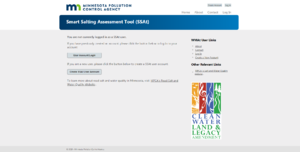
To meet this permit requirement, the MPCA recommends using the Smart Salting Assessment Tool (SSAt). The SSAt has been developed as a resource of all known current salt saving BMPs. The SSAt is a free, web‐based tool that can be used to assist public and private winter maintenance organizations in determining where opportunities exist to improve practices, make reductions in salt use and track progress. The SSAt creates a number of reports based on the data you provide describing your past, current, and future operations. These reports can be submitted to the MPCA to meet this permit requirement (Section 22.6). Before you can use the SSAt, you must create an account. The link to the tool is shown in the adjacent image.
The assessment consists of a series of multiple choice questions that cover all aspects of winter maintenance operations, such as policy, storage, application, and education. Each answer for a question is classified as an Advanced Best Practice (green), Average Best Practice (yellow), or Below Average Practice (red). The BMP Summary Report indicates how many different types of practices (advanced, best, poor, not applicable) practices you are currently implementing and how many you plan to implement in the future. The BMP list report provides detailed information on current practices. This report could be used to help you prioritize what poor practices you want to work on improving in the coming years.
Below is an excerpt of an example output from an assessment that was completed with the SSAt and the various reports generated by the tool. The actual report includes responses to questions for all BMPs that are included in the tool. The example includes an assessment of current and future operations for low and high speed roads.
- Example output from an assessment that was completed with the SSAt and the various reports generated by the tool Click on an image for enlarged view.
Related pages
To link to other pages providing information and guidance on TMDLS, click here

